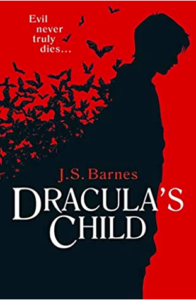As pastiche, J. S. Barnes’ Dracula’s Child is a remarkable sequel to Bram Stoker’s classic tale of vampiric horror, the legendary Dracula. Told in an epistolary manner similar to its predecessor, it tells the tale of the surviving vampire hunters some thirteen years past their execution of the dark Transylvanian lord, as pieced together by a young man on the eve of one of the greatest real-life horrors to sweep through Europe, the scourge of The Great War.
 Having retired to the countryside, Mina and Jonathan Harker are married but not entirely happily. Their son, Quincey, is a smart, sensitive boy on the verge of adolescence. The occasion of his twelfth birthday party draws Jack Seward, Abraham Van Helsing and Lord Arthur Godalming, with his delicate lady wife Caroline in tow, to the grounds of Shore Green to celebrate. But Van Helsing is seized with a fit and collapses after suddenly warning the assembled party of dire things to come.
Having retired to the countryside, Mina and Jonathan Harker are married but not entirely happily. Their son, Quincey, is a smart, sensitive boy on the verge of adolescence. The occasion of his twelfth birthday party draws Jack Seward, Abraham Van Helsing and Lord Arthur Godalming, with his delicate lady wife Caroline in tow, to the grounds of Shore Green to celebrate. But Van Helsing is seized with a fit and collapses after suddenly warning the assembled party of dire things to come.
The Harkers immediately take on the responsibility of Van Helsing’s care, as he has no other family left. The Godalmings promise to cover any additional expenses after Dr Seward sends a beautiful young nurse, Sarah-Ann Dowell, to assist the Harkers. But Sarah-Ann’s arrival seems to stir up inappropriate feelings in the Harker men, even as she worries about her own lover back in London, a gangster she’s been trying to reform. Meanwhile in Europe, two hedonistic bachelors form an attachment that sees their paths cross that of a scientist determined to bring an unusual species of bat back to England for display. But surely none of these odd events can have anything to do with Dracula, given that he was executed and put into the earth so many years since?
Finding out exactly how all this has to do with Dracula is only part of the charm of this novel, that keeps Mr Stoker’s prosody while filing off some of the duller aspects of his writing, to tell a lively tale of a resurrected vampire hellbent not only on dominion but also revenge. In expanding the ambitions of Mr Stoker’s original, the events of Dracula’s Child take a decidedly political turn, as the press, the police and even parliament itself are pulled into the shadows of a dark cabal that believes the ends justify the means. One of my favorite passages from the book involves a motorist refusing to assist our heroes because he believes that the count is bringing order back to England: a terrifying but not at all unrealistic depiction of the kind of bullheaded arrogance seen in too many “patriotic” citizens the world over.
I do wish that an explanation had been given as to the source of the many dreams and oracular pronouncements that aided our vampire hunters tho. The emphasis on faith in the text was appropriately Edwardian but I felt that the evil was better accounted for: if God was willing to work so many miracles through the subconscious, why not do more to stop Dracula and his minions directly? The wonderful set pieces felt marred by the fact that I often had no idea why some of them were happening. There was tons of creepy Gothic/gaslight atmosphere but my critical mind kept wondering how we were getting into and out of these passes.
That said, this was a perfect novel to kick off the changing seasons, as the nights get longer and the days grow chillier, and all you want to do is enjoy hot soups and snuggle under the covers with a good, scary read. We’ve been given the opportunity to speak with Mr Barnes about Dracula’s Child, so you can look forward to that interview in the coming days! The novel itself comes out today from Titan Press, and is available from all good booksellers.
